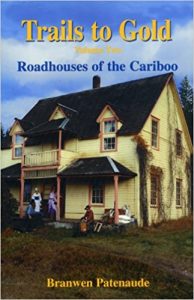The Cariboo Road provided access to the BC interior by gold-seekers in 1858, and stopping houses provided accommodation and food. The California gold rush was waning and miners were drawn to the next big (possible) find. They flocked to British Columbia, many travelling by ship to Victoria and then making their way to the Lower Mainland and into the Lower Fraser River. Branwen Patenaude (1995) described many of the first stopping houses and restaurants that sprang up along the Cariboo Road to serve the miners and adventurers who travelled the route. Stopping houses were located about every 15 to 18 miles along the Road. They were places where the stage coaches stopped so passengers could enjoy food and drink and new horses were hitched for the next leg of the journey. Patenaude drew details from the journals of a variety of travelers to provide a first glance at what people ate as they ventured into interior BC.
Hill’s Bar was a strip of land just south of Fort Yale and in autumn 1858, 400 miners were working this Bar while a reported 15,000 were working between Hope and Yale. One of the first buildings in Hill’s Bar was a roadhouse and saloon operated by Pierre Marquais, a French Canadian. The huge influx of people initially caused a great food shortage but the wealth enabled miners to dine on extravagant food such as canned beef and oysters along with much whisky, rum and champagne.
Thomas Yorke opened a restaurant in Yale in 1858 (Yorke’s House) and provided a standard miner’s meal — $1.00 for bacon, salmon, bread, tea and coffee. Luxuries like milk and butter were rare. The food at Yorke’s House seemed to lack the other early stand-by of beans. Lieutenant R.C. Mayne (see the blog post Food on the Go – 1850s Style) described in his journal the early restaurants as simply “huts” where travelers could obtain a meal of bacon, beans, bread, salt butter, and tea and coffee for one dollar. On the Lower Fraser, fresh beef, eggs, and vegetables were sometimes available. Further along the Fraser River at Boston Bar, Bishop Hills on his first journey into the area enjoyed a “delightful raspberry drink” flavoured with syrup made from the juice of wild berries.
At Lillooet, Fountain House operated by Italian miner Lorenzo Latora became well-known for its culinary delights. He developed an adjacent farm, planted grape slips imported from Italy from which he created the wine he served and raisins sold to miners. At Fountain House, Bishop Hills enjoyed a lunch of bread, cheese, radishes, raisins, and a good Claret. Also in the Lillooet area, the Dog Creek House, operated by Jane and Joseph Place was located on a large farm. Jane managed a large garden and raised chickens. Each year she canned, pickled and preserved large quantities of fruit, vegetables and meats that provided the roadhouse throughout the winter.
Patenaude, Branwen C. (1995). Trails to gold. Victoria BC: Horsdal & Shubart Publishers.

